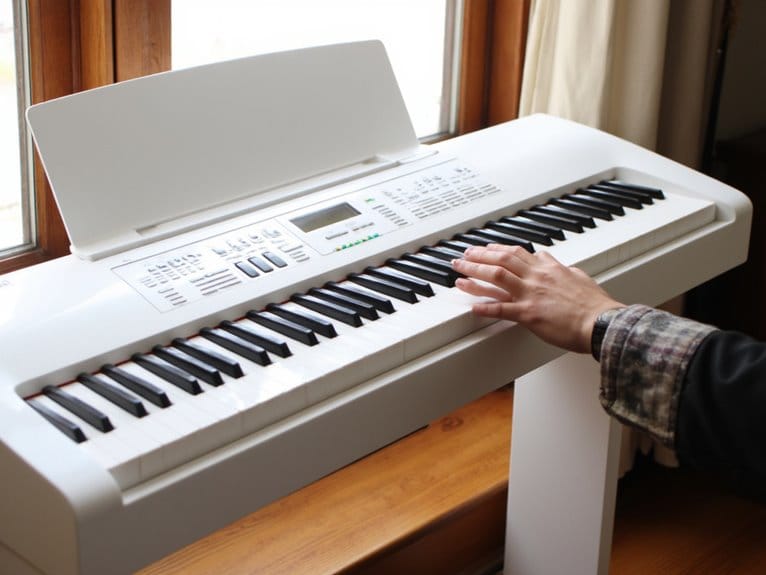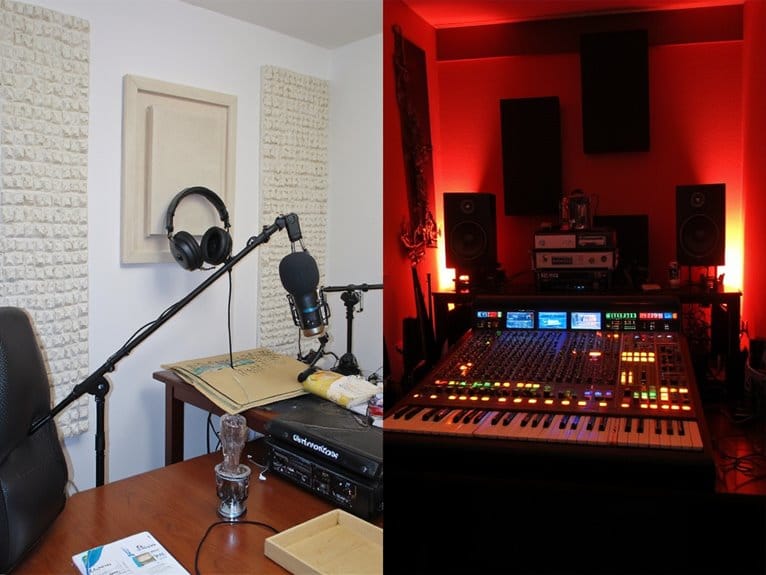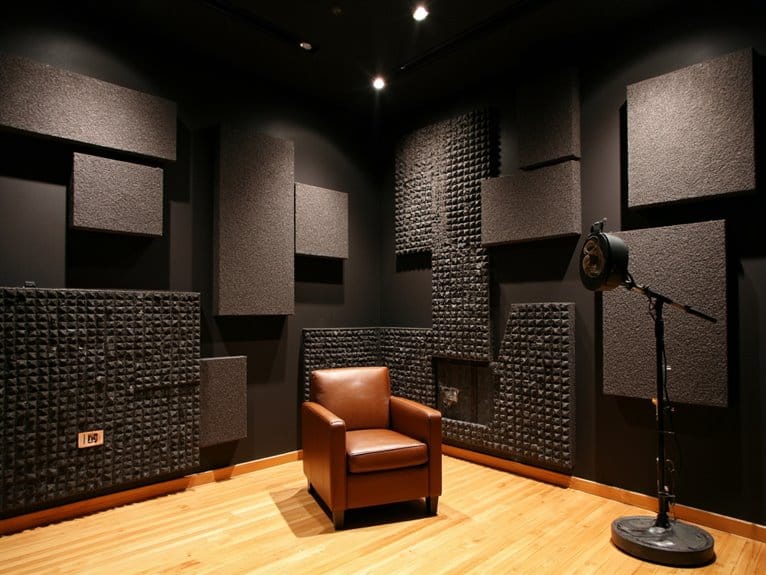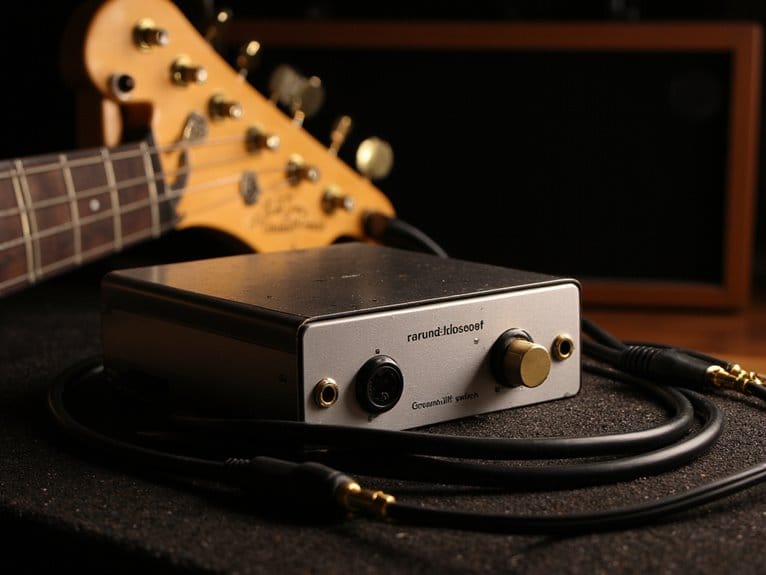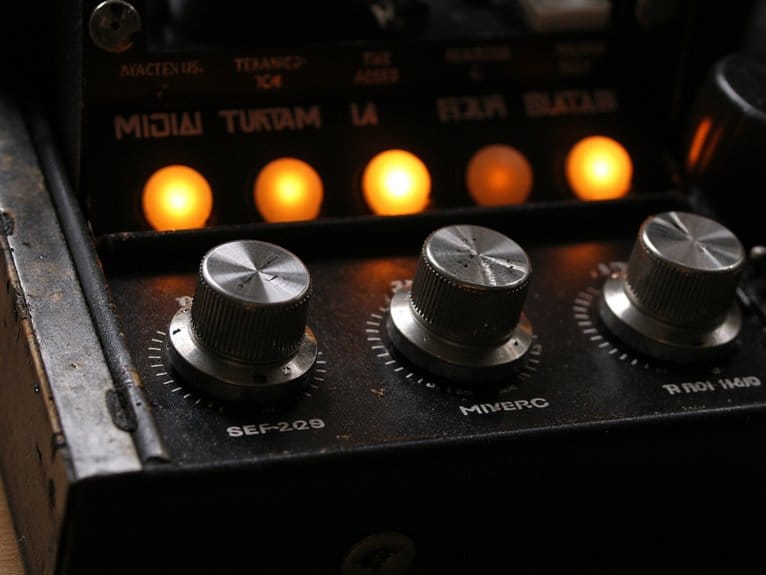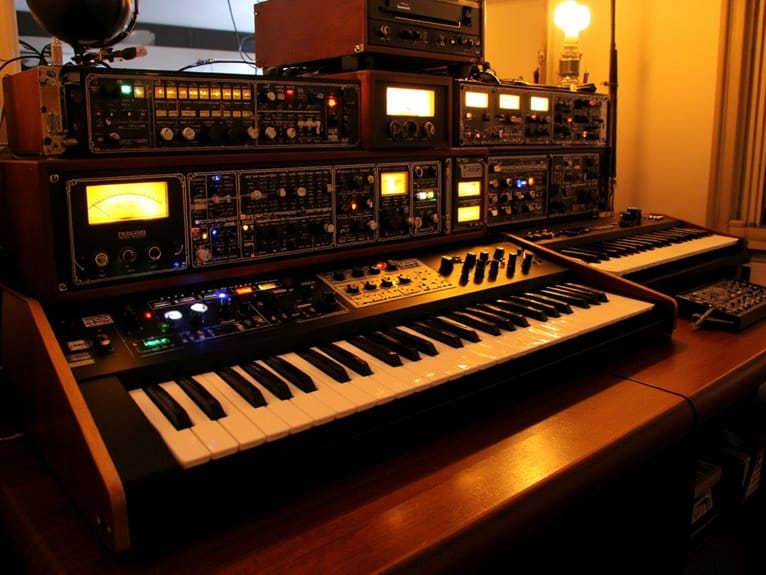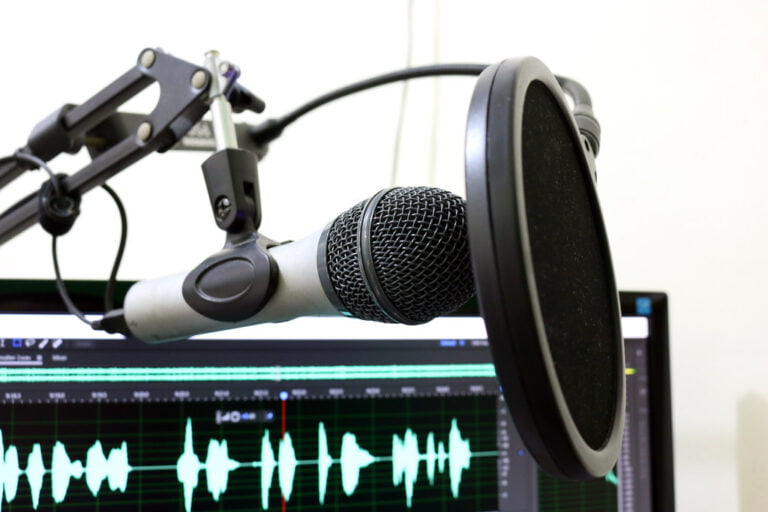How to Choose the Right Digital Piano for Your Needs
When choosing a digital piano, you’ll need to balance your budget with your skill level and musical goals. Entry-level models around $500 offer weighted keys perfect for beginners, while mid-range options between $1,000-$1,500 provide better sound engines and connectivity for intermediate players. Consider keyboard action quality, with graded hammer mechanisms offering the most authentic feel, and prioritize sound engine quality over voice quantity. Space requirements and connectivity options like USB-MIDI and Bluetooth will further guide your decision toward the perfect match.
We are supported by our audience. When you purchase through links on our site, we may earn an affiliate commission, at no extra cost for you. Learn more.
Notable Insights
- Set a realistic budget by choosing entry-level models ($500) for beginners or premium options ($3,000+) for advanced players.
- Match piano features to your skill level, prioritizing weighted keys and basic sounds for beginners versus advanced sound engines for experienced musicians.
- Evaluate keyboard action and touch response, selecting graded hammer action and velocity sensitivity that matches your playing style and technique.
- Prioritize sound engine quality over voice quantity, testing acoustic authenticity at different volumes before purchasing to ensure realistic piano tones.
- Consider size, connectivity needs, and modern features like USB-MIDI, Bluetooth, and headphone outputs based on your space and usage requirements.
Setting Your Budget and Understanding Value Tiers
When I first started helping musicians choose digital pianos, I quickly learned that establishing a realistic budget isn’t just about finding the cheapest option—it’s about understanding which price tier delivers the features you’ll actually use.
Entry-level models around $500 offer weighted keys and basic sound engines, while mid-range pianos between $1,000-$1,500 provide improved speakers, Bluetooth connectivity, and bundled accessories.
Premium models exceeding $3,000 deliver professional features like touchscreens and hybrid functionality, though budget constraints don’t necessarily limit your musical growth. The increasing affordability of digital pianos has made quality instruments more accessible to beginners than ever before.
Value maximization occurs when you match your actual needs with tier-appropriate features, comparing models within each range by voices, pedal configurations, and connectivity options rather than simply buying the most expensive option you can afford. Just like with audio equipment, professional sound quality can now be achieved at lower price points than many musicians expect. Consider whether you’re shopping for multiple players in the household, as this may justify investing in a higher-quality instrument that can accommodate different skill levels.
Matching Piano Features to Your Skill Level and Musical Goals
Your skill level and musical aspirations should drive every feature decision you make, because what works perfectly for a beginner often becomes a limitation as you advance, while advanced features can overwhelm newcomers and drain your budget unnecessarily.
I’ve seen countless students struggle with instruments that didn’t match their development stage—beginners frustrated by complex controls they’ll never use, and intermediate players hitting walls because their piano lacks the weighted keys or sound quality their improving technique demands.
The key lies in distinguishing between features that support daily practice versus those designed for performance, ensuring your investment grows with your abilities rather than holding them back. Advanced techniques may be limited by certain models with semi-weighted keys, which can impact your development of higher-level skills as you progress. Consider that electronic keyboards typically offer only 61 keys compared to the full 88-key range, which may limit your repertoire as you progress to more advanced classical pieces.
Beginner Vs Advanced Features
Rather than overwhelming yourself with every available feature, I’ve found that matching a digital piano’s capabilities to your current skill level and musical aspirations creates the most satisfying playing experience while avoiding unnecessary expenses on functions you won’t use for years.
Beginners benefit most from weighted keys, basic pedal options, and 64-note polyphony for fundamental technique development, while advanced players require graded hammer action with escapement simulation for nuanced expression.
Entry-level models typically offer 10-20 voices with simplified connectivity, whereas professional instruments provide hundreds of sounds, sound layering capabilities, and extensive MIDI integration for complex compositions.
Advanced features like adjustable touch sensitivity and wireless connectivity become essential as your skills progress, but I recommend starting with solid basics rather than purchasing beyond your current needs.
Performance Vs Practice Priorities
Once you’ve established whether beginner or advanced features suit your current level, the next consideration involves determining if your primary focus centers on practice development or performance readiness, since these two paths demand distinctly different feature priorities that’ll greatly impact your purchasing decision.
For practice-focused players, features like built-in rhythms, demo songs, and headphone connectivity become essential tools for developing practice techniques, timing skills, and maintaining consistent rehearsal schedules without disturbing others.
MIDI connectivity supports recording progress and integrating with learning software.
Performance-oriented musicians prioritize speaker power exceeding 20W, premium key actions with graduated hammer weighting, and high-quality sound engines that deliver authentic acoustic piano tones.
These features support various performance styles, from classical recitals requiring expressive dynamics to contemporary genres demanding versatile voice options and reliable amplification for audience engagement.
Evaluating Keyboard Action and Touch Response
When I test digital pianos, I’ve learned that the keyboard action—specifically how the keys feel and respond to your touch—can make or break your playing experience, whether you’re a beginner building finger strength or an advanced player executing complex classical pieces.
You’ll encounter three main weighted hammer action types, ranging from basic semi-weighted springs to sophisticated graded hammer mechanisms that replicate the heavier bass keys and lighter treble keys found in acoustic pianos.
Plus key materials that vary from plastic to synthetic ivory surfaces affecting grip and tactile feedback. The velocity sensitivity levels, which determine how the piano responds to your soft touches versus forceful strikes, work together with these physical elements to create the overall touch response that either supports or hinders your musical expression.
Weighted Hammer Action Types
While shopping for a digital piano, I’ve discovered that the keyboard action represents perhaps the most critical component separating entry-level instruments from professional-grade models. Understanding weighted hammer action types can dramatically influence your playing experience and long-term satisfaction.
Basic hammer action types provide fundamental resistance through weighted mechanisms, though they often lack the nuanced responsiveness serious players seek.
Progressive Hammer Action systems, marketed under various proprietary names like Yamaha’s Graded Hammer Action, incorporate sophisticated key weighting techniques that make lower keys heavier and upper keys lighter, mimicking acoustic piano physics.
Higher-end models feature extended pivot lengths and escapement mechanisms that simulate grand piano touch, while premium instruments employ springless designs and advanced sensor technology for professional-level authenticity and dynamic range.
Key Material Differences
After extensively testing dozens of digital pianos over the years, I’ve learned that key materials create surprisingly dramatic differences in touch response and playing comfort, often determining whether an instrument feels cheap or professional beneath your fingers.
Synthetic ivory keytops deliver the most authentic feel, absorbing moisture from your hands while providing natural grip that prevents slipping during extended practice sessions.
Plastic keys, while cost-effective, can feel slippery unless they feature textured surfaces that mimic ivory’s tactile properties.
Wooden key components offer the closest approximation to acoustic pianos, providing weight distribution and natural feel that many pianists prefer.
The key material impact on your playing experience is significant—higher-quality materials enhance touch response differences, making complex passages feel more controllable and reducing finger fatigue.
Velocity Sensitivity Levels
Beyond the physical feel that key materials provide, velocity sensitivity determines how your playing dynamics translate into actual sound output, creating the bridge between your touch and the piano’s expressive response.
Budget keyboards often lack this feature entirely, producing uniform volume regardless of how softly or forcefully you strike the keys, which severely limits musical expression.
Quality digital pianos offer multiple velocity sensitivity types, from basic three-level detection to sophisticated multi-sensor systems that capture nuanced playing dynamics.
What I find particularly valuable is velocity curve customization, allowing you to adjust how your touch translates to volume and timbre changes.
These settings can make a keyboard feel lighter or heavier without altering the physical action, accommodating different playing styles and musical genres effectively.
Assessing Sound Engine Quality and Voice Selection
When I’m evaluating digital pianos, I’ve learned that the sound engine serves as the instrument’s musical heart, determining whether you’ll hear authentic acoustic tones or synthetic approximations that lack the nuanced characteristics of a real piano.
Sound authenticity depends heavily on engine type, with sample-based SuperNATURAL engines capturing subtle acoustic characteristics through high-quality recordings, while modeling engines like PureAcoustic offer superior dynamic range within individual presets.
Sample-based engines prioritize acoustic authenticity through recordings, while modeling engines excel in dynamic expression and tonal flexibility.
Voice variety matters considerably for versatility, though I’d prioritize quality over quantity when selecting your primary piano tones.
Test instruments at various volume levels to assess dynamic range properly, listening for sympathetic resonance, natural decay times, and the clarity that distinguishes professional-grade engines from synth-oriented alternatives like ZEN-Core, which sacrifice authenticity for electronic flexibility.
Considering Size, Style, and Space Requirements
Three fundamental dimensions shape your digital piano selection: the physical footprint it’ll occupy, the aesthetic style that complements your space, and the practical requirements for placement and potential relocation. Keyboard dimensions range from compact 61-key models requiring minimal space to full 88-key instruments exceeding four feet in width, while depth varies dramatically between shallow 26cm portable units and substantial digital grands spanning three to four feet.
| Piano Type | Width/Keys | Depth Range |
|---|---|---|
| Portable | 61-76 keys | 26-35cm |
| Console/Studio | 88 keys | 45-60cm |
| Digital Grand | 88 keys | 3-4 feet |
Your placement strategies must account for doorways, electrical outlets, and room layout, particularly since studio pianos reach 45-48 inches in height. Consider weight implications carefully—while 61-key models offer portability, digital grands often require professional moving assistance, making initial placement decisions essential. Weight considerations become especially important when selecting between ultra-portable options starting at just 6 pounds and heavier models reaching 25 pounds, with the weight range directly impacting your ability to relocate the instrument for practice sessions or performances.
Exploring Connectivity Options and Modern Features
While selecting your digital piano based on size and placement sets the physical foundation for your musical journey, the connectivity options and modern features determine how seamlessly you’ll integrate the instrument into today’s digital music ecosystem.
Your connectivity exploration should prioritize USB-MIDI ports for direct computer integration with DAWs like Logic Pro or GarageBand, while Bluetooth MIDI enables wireless communication with learning apps and external devices.
I’ve found that headphone outputs facilitate silent practice, and some models include Bluetooth audio streaming to function as wireless speakers.
Modern feature advancements encompass weighted hammer-action keys with graded resistance, high-fidelity sound engines utilizing multi-layered sampling and virtual resonance modeling, plus built-in recording capabilities for capturing performances directly on the instrument.
Frequently Asked Questions
How Long Do Digital Pianos Typically Last Before Needing Replacement?
Digital pianos typically last 10-20 years before you’ll need replacement. Lifespan factors include usage intensity, environmental conditions, and maintenance quality. Higher piano quality with better components greatly extends durability, while entry-level models may require earlier replacement.
How Often Should I Clean and Maintain My Digital Piano?
You should perform key maintenance monthly with light cleaning to remove dust and debris. In high-usage environments, clean weekly. Use dust removal techniques like canned air occasionally for hard-to-reach areas.
On a final note
You’ve now got the framework to make an informed decision that’ll serve your musical journey well. Remember, the “perfect” piano doesn’t exist—only the right one for your current needs, space, and wallet. Don’t overthink every specification, but do prioritize the features that matter most to your playing style. Trust your ears, test multiple options, and you’ll find an instrument that inspires rather than frustrates your musical growth.

